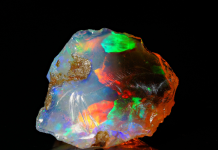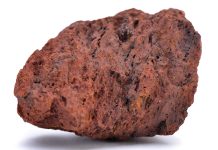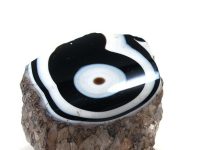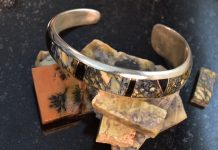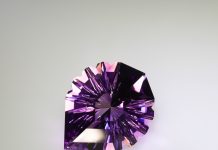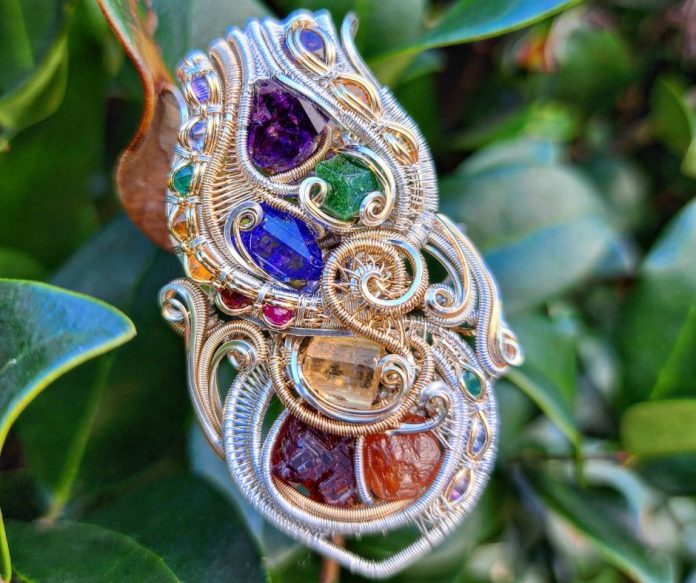
Wire wrapping techniques were used in the earliest forms of handmade jewelry. Dating back to 2000 B.C., wire wrapping has been used to secure and frame both found and created elements. It is a dynamic way to create jewelry with tension and shaping of wire.
“Wirework was discovered in ancient tombs,” explained Judi Wild, wire instructor at the William Holland School of Lapidary. “Wire wrapping is used to make a much more elegant piece than its individual materials would indicate. No heat, glue or solder; just tension and shaping of the wire make the piece come together.”
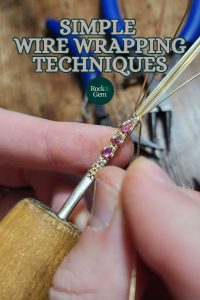
Wild explained that wire-wrapping techniques have changed over time. It continues to change and yet stays the same as pieces include polished cabochons as well as other mediums such as glass, intarsia, gemstones, beads and shells. The ongoing changes in wire work keep it fresh, new and modern.
Wild started as a student of wire work at William Holland learning the foundations of traditional wire wrapping that she now teaches. And while different styles help capture the types of stones one wants to wrap; she also prepares her students to create professional fine jewelry-level wire wrapping.
Diversity of Wire Wrapping Techniques
From the beginner to the experienced professional, here are some wire wrapping techniques that represent the diversity of wire.
Prongs
Wild explains that she teaches how to build prongs as one of the central techniques to wire wrapping. Prongs are often seen in rings that hold gemstones. They are a durable way of setting an element in a wire piece. Prongs create a seat for the stone and become part of the puzzle of a larger wire structure.
Fractal
Fractals are a more primitive wrapping strategy for holding a stone in place. Fractal pieces are often built around a gearlike base with equally spaced notches. The “gear” offers notches from which the wire wraps around a cabochon. The wrapping on the foundation of the gear creates a space for enfolding the stone crisscrossing around the stone’s edge. This versatile strategy can be seen in pieces ranging from hobbyist to professional-level jewelry.
Filigree
Merriam-Webster defines filigree as an “ornamental work of fine wire formed into delicate tracery.” In wire wrapping, filigree uses round and half-round wire to create a sense of the wire flowing around the central gemstone.
Herringbone
Herringbone is another common design strategy that was perhaps adopted from basket weaving. Herringbone uses overlapping wires as you weave around and away from a stone or bead with a precut hole. The herringbone pattern is an easy way to begin experimenting with how wire moves.
Coiling
Coiling incorporates a tight wire-on-wire strategy. Some wrappers use a drill to create this tight wrap of finer wire on a larger gauge of wire. Others prefer making this wrap by hand. Some wire wrappers are purist and committed to not adding any extra wire to their work. At the other end of the spectrum, some weavers and coilers go overboard to enhance their pieces with separate coils and hammered wire frames. While beautiful, this is one of the wire wrapping techniques that is more time-consuming and may not come back in the form of jewelry sales.
Overall, coiling can help create a very detailed wire-sculptured piece. Coiling can also be applied to hammered wire pieces to give them depth and strength.
Weaving
Wire weaving is often seen in pieces with and without gemstones. Weaving is a versatile approach that uses flexible dead-soft wire that can be curled, rolled, swirled and intricately woven creating dramatic shapes. It can also be used in freeform pieces.
Freestyling
Freestyle pieces reflect the individual jeweler’s talent, skill and creativity. It can define a distinctive style and make the work stand out. Some jewelers develop such a distinctive brand that people follow and regularly collect.
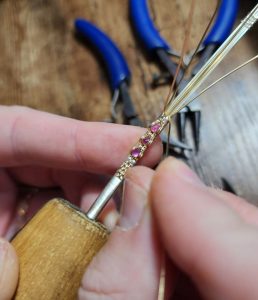
Courtesy Inna Sergeeva
Learning How to Wire Wrap
Wild explained that she wants students to understand the mechanics behind how a piece is assembled. Beginning students in her classes wrap rings, bracelets, earrings and pendants as a way of learning about the diversity of wire and its uses. Each student leaves the course with a foundational knowledge of wire wrapping techniques that help them build skills and success in design. Students also leave with as many as fourteen different pieces. Those who are more serious learners, return year after year to acquire greater skills and expertise.
Building skills has taken years for wire artist Goose Duncan, owner of Spirit Armor. Duncan began wrapping while living in Colorado where he met and learned from a friend. From the beginning, Duncan has learned by collaborating with other wrappers. Today, he meets with other wire wrappers to share ideas, experiment and get feedback. “Like any art form, the goal is to develop your own style,” Duncan explained. “Basic techniques and the way you use them become a style. It makes your work recognizable.”
Gaining Wire Wrapping Techniques & Skills
While there are lots of online videos about wire wrapping techniques, Wild and Duncan both suggest in-person learning. It is the immediate feedback available in person that is of real value in learning to wrap wire. Together wire collaborators consider form, function and the desired outcome for a piece. Duncan says that not being afraid to ask for help is also essential to gaining skills.
Early on Duncan recognized the value of daily practice using his efforts to build skill and understanding of the capacity of wire as well as develop his use of gems. He observed that some are afraid to add more wire to a piece, but he finds it useful as a tool in design development. “I probably add a hundred pieces of wire that help create a sense of flow and depth.”
Both Wild and Duncan expressed the need to understand when a piece is finished. This skill comes with time and experience. Wire is a forgiving medium and there are many ways to address challenges in a piece. It may mean taking a piece completely apart or it may mean going forward and figuring out how to work within and outside the foundational aspects of a piece. A wire artist may discover that choosing the stone and the style changes as the piece itself evolves – as if the artist, stone or stones and wire are in a deeper creative conversation.
Wild adds, “I want my students to leave understanding what a properly finished piece looks and feels like. Someone shouldn’t feel any wire ends, a finished piece should be smooth and have a high level of professionalism.”
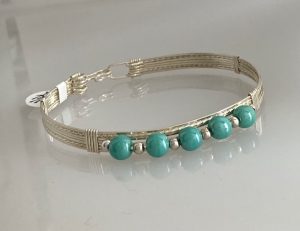
Courtesy Judi Wild
Wire Types
There are many different types of wire wrapping materials including sterling silver, gold filled, gold, copper, steel and Argentinian silver. These wire options include round, half-round which is domed with a flat side, square, twisted square, flat and textured flat.
Followed by all these options are wire hardness and gauges. The higher the gauge number the finer and smaller the wire. Hardness comes in variations such as deadsoft, half-hard and full-hard and indicates how firm the wire will be for bending.
“I use different gauge wire – square, round and half-round for each piece,” said Duncan. Square, 20-gauge wire often provides the main framework for pendants. Duncan uses four base wires to create the front and back foundation of a piece. From there he builds with half-round on top of the base to incorporate the stones. He uses wire to accent to how the gems hang. Duncan is attentive to the colors of the gems themselves, explaining that they are part of the visual flow of any piece – not just the wire but the wire in combination with a series of stones.
Wire Wrapping Techniques Need the Right Tools
In terms of tools, Wild suggests that beginners consider purchasing a smooth jawed flat nose plyer, quality flush cutters and medium to fine round-nosed plyers. “You can do a lot with these three tools,” she said. “They are an excellent place to start. Most hobby craft stores sell wire in square and round as a starting point as well.” Wild also suggests finding books with demonstration close-up images. Books can provide a good foundation and more basic information about tools, wire weights and shaping.
Finally, Wild says she wishes she’d thought to keep a notebook when she started to keep track of her work and growth as an artist. She now uses a notebook to note the date, what she’s wrapped, the wire and the stones she used.
This story about wire wrapping techniques previously appeared in Rock & Gem magazine. Click here to subscribe. Story by Deb Brandt.




